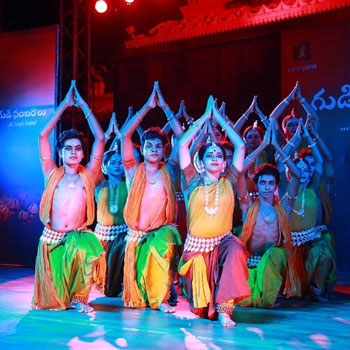Perini Shivatandavam: Telangana's Dynamic War Dance from the Kakatiya Dynasty

The art form linked to the illustrious Kakatiya Dynasty is Perini Shivatandavam, a war dance that originated in the 10th century when the Kakatiya dynasty was the dominant power in Telangana.
Historians note that Perini Shivatandavam bears similarities to the intense dance forms practiced by the indigenous peoples of New Zealand and America. Additionally, the renowned Thousand Pillars Ramappa Temple in Warangal, dating back to the 13th century, features numerous statues and figurines that depict the dance styles and poses characteristic of Perini Shivatandavam.
During preparations for war, it was customary to perform Perini Shivatandavam—a vigorous pre-war dance by male artists—to invoke Lord Shiva's blessings and guidance for victory.
This dynamic dance form required agile male dancers who performed in the king’s palace and temples, thereby boosting the morale of warriors. As devout followers of Lord Shiva, the Kakatiya kings held Perini Shivatandavam in high religious regard. Most performers were members of the Vir Saiva cult.
Like many traditional art forms, Perini Shivatandavam experienced a significant decline after the Kakatiya era. However, it was revitalized by Padma Shri Nataraja Ramakrishna, an expert in dance and temple traditions, who established the Perini Institute in Warangal to preserve this divine art. The institute continues to nurture hundreds of dancers today.
Perini Shivatandavam is recognized as a classical dance form, characterized by its valor and fury. Audiences can enjoy its vibrant, fast-paced acrobatic movements perfectly in tune with the rhythmic sounds of drums, conchs, bells, and rapidly changing jathis (syllables), all celebrating Lord Shiva. The dancers wear dhotis and are adorned with ornaments on their necks, hands, and ankles (salangai).
Interestingly, there is a variation known as Perini Lasyam, performed by female artists, which combines elegance with vibrancy. To promote and preserve this unique art form, the Government of Telangana has declared it the state dance and features it prominently at the annual GoHeritage Warangal Run.
Whether it's you or me, watching Perini Shivatandavam is truly a magical experience.
FAQs:
What is Perini Shivatandavam?
Perini Shivatandavam is a vigorous war dance originating from the 10th-century Kakatiya Dynasty in Telangana, performed to invoke Lord Shiva's blessings for victory.
What historical significance does Perini Shivatandavam hold?
This dance was traditionally performed by male warriors before battles to boost morale, and it is depicted in the statues and figurines of the Thousand Pillars Ramappa Temple in Warangal.
Who revitalized Perini Shivatandavam, and how is it preserved today?
Padma Shri Nataraja Ramakrishna revitalized Perini Shivatandavam and established the Perini Institute in Warangal, which continues to train hundreds of dancers.
What characterizes the performance of Perini Shivatandavam?
The dance is known for its fast-paced, acrobatic movements, rhythmic sounds of drums, conchs, bells, and rapidly changing jathis. Dancers wear dhotis and are adorned with ornaments.
Is there a variation of Perini Shivatandavam performed by female artists?
Yes, Perini Lasyam is a variation performed by female artists, combining elegance with vibrant movements.